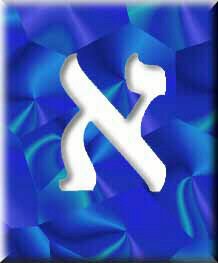 ALEF
ALEFThe Paradox: God and Man
The alef is formed by two yuds, one to the upper right and the other to the lower left, joined by a diagonal vav. These represent the higher and lower waters and the firmament between them, as taught by the Ari z"l ("Rabbi Isaac Luria of blessed memory," who received and revealed new insights into the ancient wisdom of Kabbalah)
Water is first mentioned in the Torah in the account of the first day of Creation: "And the spirit of God hovered over the surface of the water." At this time the higher and the lower waters were indistinguishable; their state is referred to as "water in water." On the second day of Creation God separated the two waters by "stretching" the firmament between them.
In the service of the soul, as taught in Chassidut, the higher water is water of joy, the experience of being close to God, while the lower water is water of bitterness, the experience of being far from God.
In Jewish philosophy, the two intrinsic properties of water are "wet" and "cold." The higher water is "wet" with the feeling of oneness with the "exaltation of God," while the lower water is "cold" with the feeling of separation, the frustration of experiencing the inherent "lowliness of man." Divine service, as taught by Chassidut, emphasizes that in fact the primary consciousness of both waters is the sense of the Divine, each from its own perspective: from the perspective of the higher water, the greater the "exaltation of God," the greater the oneness of all in His Absolute Being; from the perspective of the lower water, the greater the "exaltation of God," the greater the existential gap between the reality of God and that of man, thus the inherent "lowliness of man."
The Talmud tells of four sages who entered the "Pardes," the mystical orchard of spiritual elevation reached only through intense meditation and Kabbalistic contemplations. The greatest of the four, Rabbi Akiva, said to the others before entering, "When you come to the place of pure marble stone, do not say 'water-water,' for it is said, 'He who speaks lies shall not stand before my eyes.'" The Ari z"l explains that the place of "pure marble stone" is where the higher and the lower waters unite. Here one must not call out 'water-water,' as if to divide the higher and lower waters. "The place of pure marble stone" is the place of truth--the Divine power to bear two opposites simultaneously; in the words of Rabbi Shalom ben Adret: "the paradox of paradoxes." Here "the exaltation of God" and His "closeness" to man unite with the "lowliness of man" and his "distance" from God.
The Torah begins with the letter beit: "Bereishit (In the beginning) God created the heavens and the earth." The Ten Commandments, the Divine revelation to the Jewish People at Sinai, begin with the letter alef: "Anochi [I] am God your God who has taken you out of the land of Egypt, out of the house of bondage." The Midrash states that "higher reality" had been set apart from "lower reality," for God had decreed that neither higher reality descend nor lower reality ascend. In giving the Torah, God annulled His decree, He Himself being the first to descend, as it is written: "And God came down on Mount Sinai". Lower reality, in turn, ascended: "And Moses approached the cloud...." The union of "higher reality," the upper yud, with the "lower reality," the lower yud, by means of the connecting vav of Torah, is the ultimate secret of the letter alef.
No comments:
Post a Comment